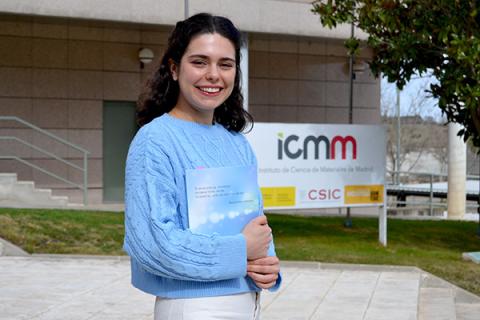Beatriz Pérez defends her Thesis at ICMM: "My research has a direct application on quantum technologies"
Advised by Gloria Platero and Álvaro Gómez León, Pérez studied the field of light-matter interaction.

A path comes to an end... but another one is opening. Beatriz Perez, after some years studying at the Institute of Material Science of Madrid under the supervision of Gloria Platero (ICMM) and Álvaro Gómez León (UCM), is defending her doctoral thesis this Friday, March 17, at Ciencias Físicas Faculty at Universidad Complutense de Madrid. Her work, entitled 'Topological systems interacting with classical and quantum light' has "a direct application on quantum technologies", explains the researcher, whose thesis is on theoretical Physics.
"From a theoretical point of view, we investigate how the interaction with light can alter the topological features of a system, in two different aspects: first, by modifying the existing phase or by inducing non-trivial features in an otherwise trivial sample, and second, by hindering them", explains the researcher on the abstract of the thesis, where she adds the main questions she has already answered: "Are there any broken symmetries in the interacting system? What is the fate of the edge states in a finite system? Are they topologically protected? Is the topological invariant well-defined?."
Pérez says that she studied her TFM at ICMM, and then she decided to stay: "Gloria offered me the possibility to extend the results of the Master's Thesis (that I also did under her direction) as a first step into what would later become my Ph.D. Thesis. We thought of an appealing research project and I got some funding from the Ministry to make it happen."
Asked about explaining her research to a non-scientific audience, she says: "I develop theoretical models to understand the interaction between quantum materials and electromagnetic fields as light". She continues explaining what is important about quantum materials: "They gather a plethora of distinct phases, whose properties at a macroscopic lengthscale are rooted in quantum mechanical laws. What is interesting about them is that those surface states are robust to certain perturbations or material defects, and this makes them ideal candidates for many interesting applications in quantum technologies". Because of that, her research "deepens in the field of light-matter interaction to learn how the topological properties of an insulator can be modified, tuned or even induced externally using the electromagnetic field".
"My research has a direct application on quantum technologies", she points out. And then she adds: "Topological edge states can encode information in a more robust way since topological properties are naturally protected against certain perturbations or disorder. This can be used for quantum state transfer protocols, or for quantum computation. Then, light provides us with an external knob to design the topological properties of the material".
She has been at the ICMM so many years, and she has learned so many lessons: "While it is true that in these years I have learned a lot about science and how it is done, the most valuable lessons belong to the personal sphere," she says. "Science has brought to my life a lot of amazing people that have been a turning point in my personal growth. A Ph.D. can be quite demanding and challenging, and it tests your self-confidence and resilience. In this context, what I have learned is that a helping hand that comes to you at the right time can make a huge difference. It is very important to find people that are willing to support you in bad times, but also to be committed to helping others in return".
In the end, she acknowledges that she has acquired a broad range of skills during her Ph.D. that are not directly related to technical knowledge: "I have worked as part of a team and as a solo player; I have learned to extract conclusions from the evidence but also to be critical with my own ideas; I have learned to discuss with others and to make myself heard, but also to listen; I had the opportunity to talk about my research in scientific conferences, but also to explain the most basic principles to kids and make science fun."
The latter point is important, as the researcher is so aware of the important of outreach. In fact, she became a scientist thanks to her teacher: "he was truly an inspiration for me on those days: he was very enthusiastic and made me feel that love for physics", she says, and also explains that doing science "has become a beautiful opportunity to enjoy my taste for art and literature as well". To sum up, she obviously has a lot of people to thank, but especially her parents: "My role models are and will always be my parents. They have taught me the value of working hard and trying your best and above it all, the importance of enjoying the journey, regardless of the final outcome".
Now, after finishing the thesis, she is not sure about her future, but she has an idea: "I would like to continue doing research, so let's see what the future brings"
Pérez is also participating this year in the 'I investigate, I am CSIC' contest, and tells of her work in this very informative way: if you watch the video and click 'like', you will help her win.
-- Ángela R. Bonachera (text) and Carlos Arroyo/Morgan (photo) -- Communication Unit--
Instituto de Ciencia de Materiales de Madrid (ICMM)
Sor Juana Ines de la Cruz, 3
Cantoblanco, 28049
Madrid, España
Telephone: (+34) 91 334 90 00
Email: @email
Communication Office: @email

Acknowledge the Severo Ochoa Centres of Excellence program through Grant CEX2024-001445-S/ financiado por MICIU/AEI / 10.13039/501100011033

Contacto | Accesibilidad | Aviso legal | Política de Cookies | Protección de datos